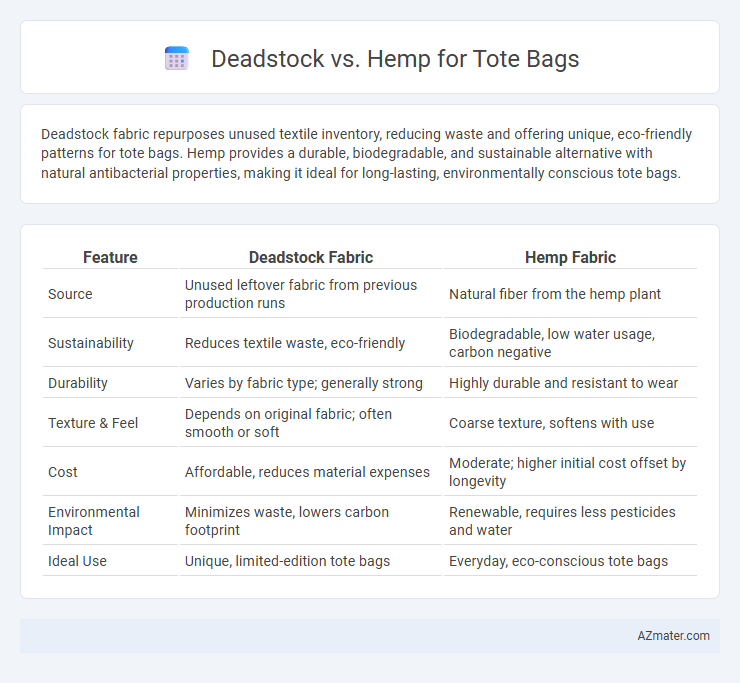Deadstock fabric repurposes unused textile inventory, reducing waste and offering unique, eco-friendly patterns for tote bags. Hemp provides a durable, biodegradable, and sustainable alternative with natural antibacterial properties, making it ideal for long-lasting, environmentally conscious tote bags.
Table of Comparison
| Feature | Deadstock Fabric | Hemp Fabric |
|---|---|---|
| Source | Unused leftover fabric from previous production runs | Natural fiber from the hemp plant |
| Sustainability | Reduces textile waste, eco-friendly | Biodegradable, low water usage, carbon negative |
| Durability | Varies by fabric type; generally strong | Highly durable and resistant to wear |
| Texture & Feel | Depends on original fabric; often smooth or soft | Coarse texture, softens with use |
| Cost | Affordable, reduces material expenses | Moderate; higher initial cost offset by longevity |
| Environmental Impact | Minimizes waste, lowers carbon footprint | Renewable, requires less pesticides and water |
| Ideal Use | Unique, limited-edition tote bags | Everyday, eco-conscious tote bags |
Introduction to Sustainable Fabrics: Deadstock and Hemp
Deadstock and hemp fabrics both offer sustainable solutions for tote bags by minimizing environmental impact through resource efficiency. Deadstock fabric repurposes excess or leftover textiles from fashion production, reducing waste and conserving materials that would otherwise be discarded. Hemp, a fast-growing biofiber, provides a durable, biodegradable option requiring minimal water and pesticides, making it an eco-friendly choice for sustainable tote bags.
What is Deadstock Fabric?
Deadstock fabric refers to unused, leftover textiles from previous fashion productions that remain unsold or unused in warehouses. Utilizing deadstock fabric for tote bags reduces waste by giving new life to high-quality materials, minimizing the need for new resource consumption. This sustainable approach contrasts with hemp, a natural fiber known for durability and eco-friendliness, but deadstock offers a unique opportunity to repurpose existing fabrics without additional environmental impact.
Exploring Hemp as an Eco-Friendly Material
Hemp offers a sustainable alternative to traditional deadstock fabrics for tote bags due to its rapid growth, low water usage, and natural resistance to pests, reducing the need for harmful pesticides. Unlike deadstock, which repurposes leftover textiles, hemp is cultivated with minimal environmental impact and is biodegradable, promoting a circular economy. Choosing hemp tote bags supports eco-friendly fashion by combining durability, renewable resources, and reduced waste, aligning with green consumer values.
Environmental Impact: Deadstock vs Hemp
Deadstock fabric repurposes unused or surplus textiles, significantly reducing waste by diverting materials from landfills and minimizing the demand for new resource-intensive production. Hemp, a highly sustainable crop, requires minimal water, pesticides, and grows quickly, contributing to lower carbon emissions and enhanced soil health during its cultivation. Choosing deadstock or hemp for tote bags both supports environmental conservation, with deadstock maximizing textile reuse and hemp promoting eco-friendly agriculture practices.
Durability and Longevity of Tote Bags
Deadstock fabric offers exceptional durability for tote bags due to its tightly woven fibers and previously unused condition, ensuring minimal wear over time. Hemp, renowned for its natural strength and resistance to stretching and tearing, provides superior longevity while becoming softer with use without compromising sturdiness. Tote bags made from either deadstock or hemp materials maintain structural integrity and aesthetic appeal for many years, making them reliable choices for sustainable, long-lasting accessories.
Aesthetic and Design Versatility
Deadstock fabric offers a unique aesthetic with vintage patterns and textures that enhance the tote bag's distinctiveness and appeal, making each piece one-of-a-kind. Hemp provides a natural, earthy look with a coarse texture that complements minimalist and eco-conscious designs, offering durability without sacrificing style. Both materials allow for versatile design options, but deadstock excels in bold, eclectic looks while hemp supports sustainable, timeless designs.
Cost Comparison: Deadstock vs Hemp
Deadstock fabric offers a cost-effective option for tote bags due to its availability as surplus materials at significantly lower prices than new fabrics. Hemp, though eco-friendly and durable, typically incurs higher costs associated with sustainable farming and processing methods. Choosing between deadstock and hemp hinges on budget constraints and the value placed on sustainability and material longevity.
Ethical Sourcing and Transparency
Deadstock fabric, sourced from surplus textile inventory, offers ethical advantages by reducing waste and promoting sustainable reuse in tote bag production. Hemp, praised for its minimal environmental impact and fast growth cycle, ensures ethical sourcing through renewable agriculture and low pesticide use. Transparency in deadstock relies on detailed inventory tracking, while hemp brands often provide certifications verifying organic practices and fair labor standards.
Consumer Appeal and Market Trends
Deadstock fabric appeals to eco-conscious consumers by offering unique, limited-edition tote bags that emphasize sustainability through repurposed materials. Hemp tote bags attract buyers seeking durability and natural fiber benefits, aligned with growing trends favoring organic, biodegradable products in fashion. Market data shows an increasing demand for both materials, with deadstock favored for creative exclusivity and hemp prized for its environmental resilience and longevity.
Choosing the Right Material for Your Tote Bag
Deadstock fabric offers a sustainable choice by repurposing unused textiles, reducing waste and lowering environmental impact, while hemp provides durability, natural antimicrobial properties, and biodegradability for eco-conscious consumers. When choosing the right material for your tote bag, consider factors such as environmental footprint, fabric strength, and aesthetic preferences to balance sustainability with functionality. Hemp's resistance to wear and deadstock's unique patterns both enhance the tote bag's appeal, making material selection crucial for a stylish, durable, and eco-friendly accessory.

Infographic: Deadstock vs Hemp for Tote Bag
 azmater.com
azmater.com